The main action continues to be at the Omicron post. There’s still some background developments and near term developments worth noticing, but for now nothing that seems as important or that seems terribly urgent, so read that first.
Executive Summary
- Omicron is here and will take over soon.
- We might not do much about it until far too late.
- And that’s probably better than the alternative.
Also some other stuff, like Will Eden’s excellent tweetstorm below.
Let’s run the numbers.
The Numbers
Predictions
Prediction from last week: 750k cases (+2%) and 8,800 deaths (+5%).
Results: 747k cases (+2%) and 8,813 deaths (+5%).
Prediction for next week: 862k cases (+15%) and 9,050 deaths (+3%).
Those were some pretty good predictions. Don’t count on it happening again any time soon. Stuff’s about to get weird.
The case growth depends on how far along we are in Omicron taking over, and when those tests results will come in and how many people will get tested if the cases are mild. If we take the 2.9% for the period ending 12/11 seriously, we now are moving ahead 12 days, I’ll guess the true general doubling time is 3 days, so for the sample we’ll get it’s going to be something like 18% (+12% from previous levels) Omicron, and cases of Delta likely remain roughly level, with more upside than downside for the count. It’s already at or last that level in the specific places we’re measuring, but it makes sense that they’d be ‘ahead’ of other areas with much larger populations. And we’ll likely see some mitigation. So I’ll go with +15%, but the error bars are wildly higher than before. So many variables.
Deaths

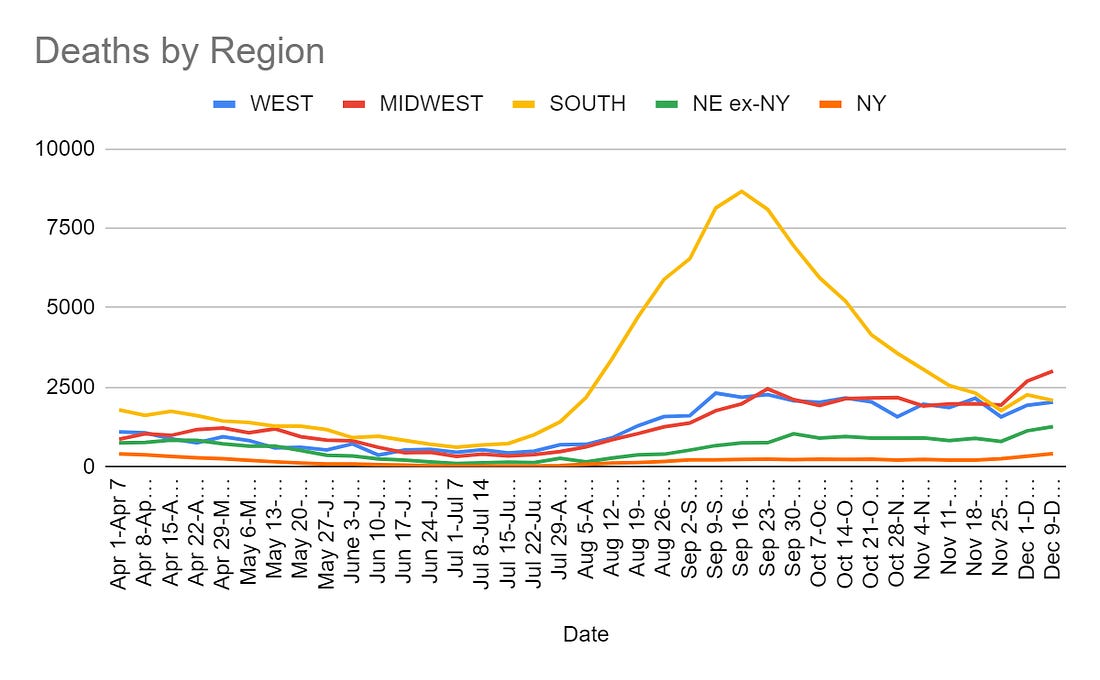
Deaths are straightforward, no reason to expect major change. Paxlovid remains illegal, Omicron isn’t here yet for long enough.
Cases

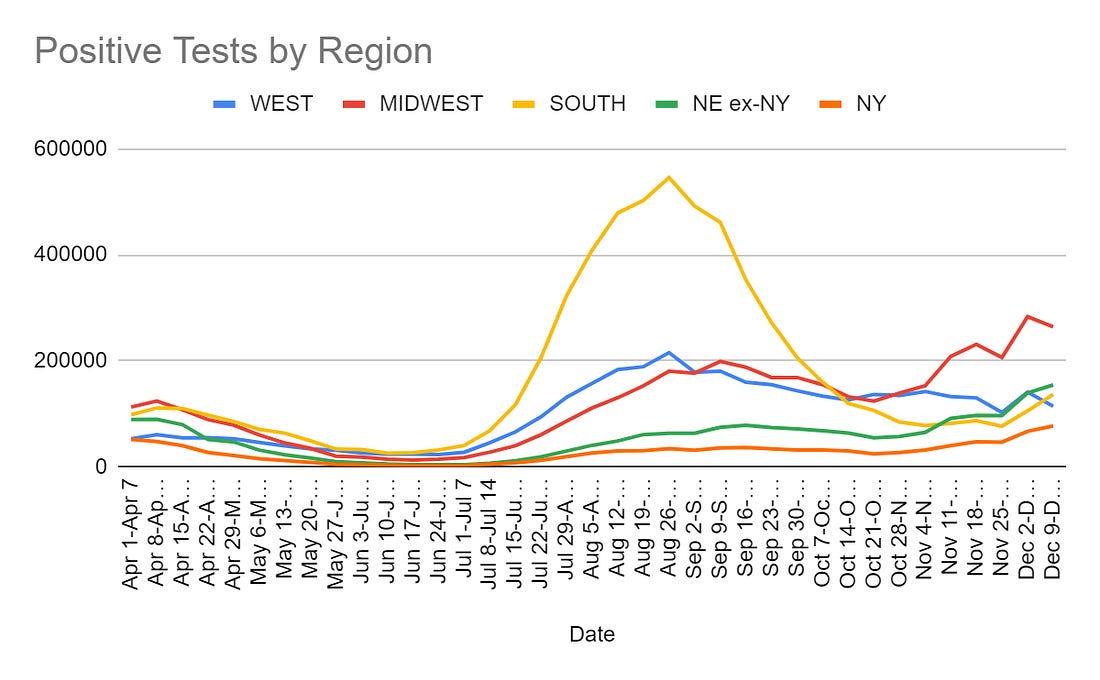
This is the question. We saw some regional movement last week, it’s probably largely random reporting fluctuations, except that the rise in the Northeast is very real. Going forward it’s all about Omicron. It’s super hard to time it, and what comes up on tests is several days behind what’s actually happening (e.g. a full doubling time) but my guess is that we’re already above 10% and increasing fast. London is our future, it’s merely unevenly distributed for a limited time.
So, how about Paxlovid? Can we hurry?
Paxlovid Remains Illegal
The final numbers are in, and they look good. Efficacy holding steady at 88%, no deaths in the treatment group, actively fewer ‘side effects’ in the treatment group compared to controls (presumably because controls had Covid-19, which causes a lot of ‘side effects’).
So now we have four questions:
- When will Paxlovid become legal?
- How much Paxlovid will be available?
- While supply is limited, who gets that supply?
- When supply isn’t limited, how do we get it to people in time?
The answer to when is around the end of the year. As of writing this the prediction market now again has it as a favorite at 55%, I hope some of you are making yourselves some money. There isn’t that much uncertainty here at this point, as I understand it, and we’ll almost certainly have Paxlovid by mid-January.
That brings us to question two. There are going to be enough doses this year for 200,000 patients. That’s two days worth of known cases right now, one day by year’s end, so indeed going forward production (as crippled by worries about approval) will be the central limiting factor. Pfizer will have 80 million treatments available next year, of which the US Government has bought 10 million. We don’t have information on the rate at which this can ramp up, which will be important because the bulk of the cases in 2022 are probably going to be in the first two months, and that’s also when we need to use Paxlovid to reduce pressure on hospitals.
Weekend Editor expects a narrow authorization:
Still, I’m betting on a narrower FDA Emergency Use Authorization. The risk of ritonavir interacting with other drugs is high (though known, so physicians have to check before prescribing), and the more widely an antiviral (or, for that matter, antibacterial) is used the more likely resistance mutations happen. So probably it’s going into the highest-risk populations first.
I have a very hard time believing that we’re going to deny Paxlovid to people who have tested positive because we’re worried about it causing resistance, even if that was wise. I also have a hard time believing we’re going to have abundant supply and hold it back from some population for ‘risk’ reasons, in the sense that this is so obviously insane even after all this we aren’t actually that insane right? Right? Oh no, at least half the time I type those words the answer is not what I’d like?
What I do expect is for this to be used as a de facto rationing method, with at least one period where there’s a surplus of supply that is sitting unused for a while, which brings us to the next question.
Given supply will be limited at crunch time, who gets that limited supply?
Presumably we should reserve doses for the elderly, whether or not it’s worth adjusting for conditions that constitute additional risk factors, because Paxlovid is even more effective in those cases and those cases have much higher baseline risk. There will be fights over geographic distribution, no doubt, but after that this part’s easy.
Then there’s the big problem. There’s two 70-year-old women, each positive for Covid-19. There’s only one difference between them, which is that one is vaccinated and the other is not vaccinated. You have one set of doses. Who gets it?
The argument for treating the unvaccinated patient is obvious. She’s at much higher risk. Can you imagine doing otherwise?
Yes, because the argument for treating the vaccinated patient is also obvious. Who is going to get vaccinated if it means you won’t get treatment? What would reaction be like if we were rewarding the unvaccinated with life saving medicine over the vaccinated? When that medicine was about as effective as vaccination? Can you imagine?
In other contexts, this choice has already been made in favor of the vaccinated, but this makes it that much more stark. My preference would be to announce the policy now, especially if it’s going to be vaccinated first. If you’re going to go for motivation and good incentives over the in-the-moment saving of lives, make it count.
Vaccine Effectiveness
Previous infection also works, and quite well, and all that, says study.
For vaccine effectiveness against Omicron, see the Omicron posts.
Vaccine Mandates
What counts as ‘fully vaccinated?’ That’s changing in many places, with a lot of Europeans being reclassified as effectively unvaccinated until they get their boosters, which in many places severely limits the ability to live a normal life. Then it’s going to periodically happen again.
It’s important to be ‘fully vaccinated’ or you’ll lose access to important services.

Private groups can get in on the act. The Metropolitan Opera here in New York is requiring boosters.
Another problem is that even if you’re convinced that you want a booster, our logistical systems aren’t up to the task. Everyone from the elderly to children is having trouble getting vaccine appointments, despite plenty of supply. If we want to get back to levels we had early in the year, we’ll have to actually be professionals and talk logistics.
The flip side of this is that if you don’t understand why NHS (healthcare) workers need to be vaccinated, you’re not going to make it.

It’s one thing to think there’s two sides to this, but how tone deaf do you have to be to call it ‘totally wrong’?
NPIs Including Mask and Testing Mandates
Colorado Governor Jared Polis lifts mask mandate, promises not to institute a new one for Omicron, someone should open a prediction market on whether he’ll be eating his words by March. Which he might well have to do, but in the meantime you have to love the explanation.
Colorado Gov. Jared Polis, a Democrat, declared in a new interview that the COVID-19 emergency is “over” and that he won’t be implementing another statewide mask mandate in response to the spread of the Omicron variant, explaining that if people aren’t vaccinated at this point, it’s their “own darn fault” if they get sick.
“Everybody had more than enough opportunity to get vaccinated,” Polis told Colorado Public Radio on Friday. “Hopefully it’s been at your pharmacy, your grocery store, a bus near you, [or at] big events. At this point, if you haven’t been vaccinated, it’s really your own darn fault.”
“Those who get sick, it’s almost entirely their own darn fault,” he continued. “I don’t want to say that nobody [will get the virus if they’re] vaccinated, but it’s very rare. Just to put it in perspective, of the about 1,400 people hospitalized, less than 200 (or 16 percent) are vaccinated. And many of them are older or have other conditions. Eighty-four percent of the people in our hospitals are unvaccinated, and they absolutely had every chance to get vaccinated.”
I strongly agree with the sentiment that this is an excellent compromise. Instead of imposing stupid restrictions as a Sacrifice to the Gods and blaming it on those who we claim did us wrong, we tell those people they’re being morons and that what happens to them is their own darn fault. It’s a deal.
There is a catch. If Omicron wasn’t about to hit us I’d be fully on board with this, but given it’s hitting about (check notes) right now I am deeply curious how far ahead he has thought this through.
Meanwhile, Governor Hochul in New York has instituted her new indoor mask mandate. Saratoga County has declared they will not enforce the order. Neither will Nassau.
Reactions were mixed, here’s the first reply and its first reply in turn:


Ah, choices and markets at work.
Or an alternative interpretation from Alex Tabarrok.
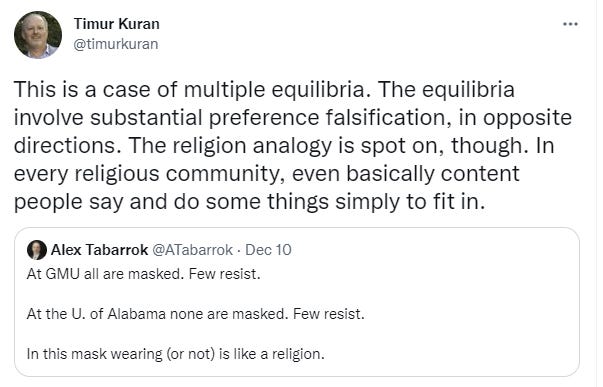
If you want a test in New York you do not want to go to CityMD. There’s another two screens worth of this line, and it matches my experiences, and these resources are needed for other medical issues. Instead go to one of the places at this link, or one of the in-street tents. I got a test last week, it was free, I didn’t even have to give insurance, I was done in five minutes and got it back the next day.
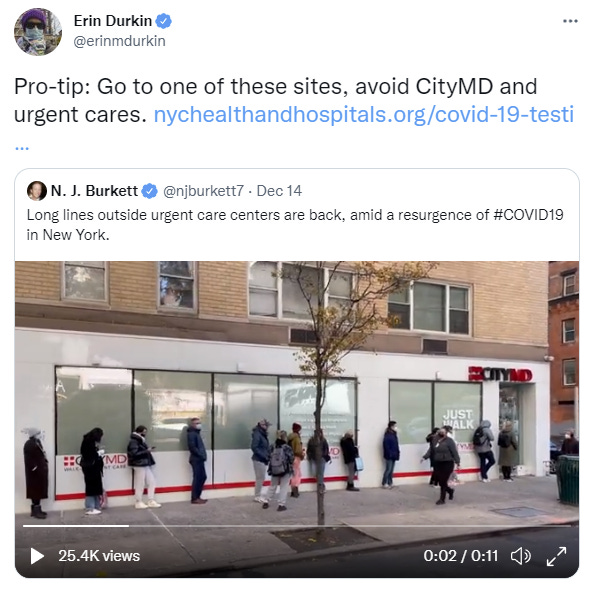
If you get to urgent care before they open, you have a shot of getting urgent care in a timely manner. If you otherwise need urgent care, you won’t be getting it all that urgently.
I’m guessing this is similar in many other places, but I don’t know for sure.
So why don’t we have all those free at-home tests? Tell it to me straight, doc.

And there’s this, I mean I have a suggestion or two I could make but what else is there to say:
Just 13 companies are authorized to sell over-the-counter tests in the U.S., though many more are still waiting to get green-lighted by the FDA. Even amid fears of a Covid-19 resurgence, Biden officials fretted that intervening now would stifle competition and discourage newer test makers from scaling up their manufacturing.
“It would’ve capped the market and not done anything to drive prices down,” a senior administration official said.
Instead, the official added, the administration is betting that staying out of the way “gets more players into the market, which gets more tests in the market, which drives down the cost.”
They also note how many tests are available.
The current supply of over-the-counter tests is also a practical barrier. The number of at-home tests being manufactured per month is expected to reach 200 million this month, 240 million in January and 300 million in February.
I have a feeling that if the government started buying tests at good prices, and/or didn’t make many potential Covid-19 tests illegal (including many that are used a lot in Europe) that we would see expanded supply.
It’s also worth noting that a lot of the tests we do have are being used on very low-value things, like testing four year olds once a week. If we don’t have enough for people who have reason to think they might have Covid-19, we should think about to what extent such policies are making things actively worse.
NFL Players Association calls for a return to daily testing. They’ve been advocating for this all season, and are reiterating this call. They’re right, this is a high value place to use our tests, and we should use them here. Kudos to them. No football, no peace.

This is a very non-representative sample, of course, but another data point:

Before, support rose and fell largely based on how bad things were. But even before Omicron, things were starting to get worse. Yet support for countermeasures was falling. There’s a general sense of having had enough, even more so than before. The question is, will that matter when the logic of exponential growth starts hitting like a truck?
On the lighter side, from Ontario, the very definition of a half-measure.
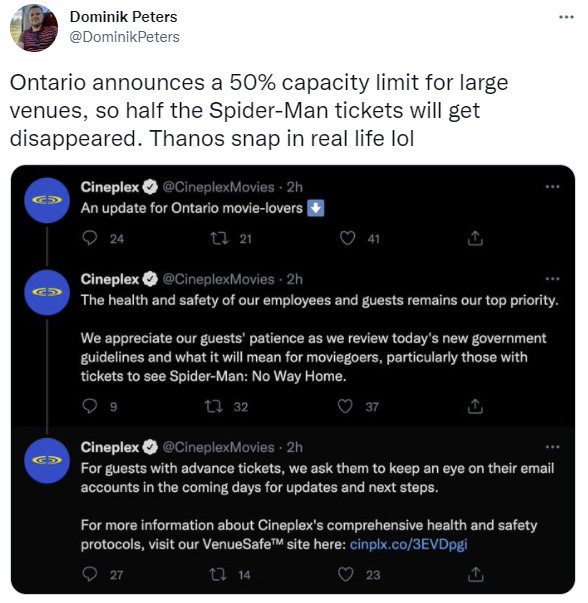
Think of the Children
In Other News
Words of wisdom from my old friend William Eden on how we’ve navigated the pandemic, and the choices facing us going forward. Here’s Eric Weinstein’s endorsement, and then the since I would tell you to read the whole thing, sure why not, here’s the whole thing.
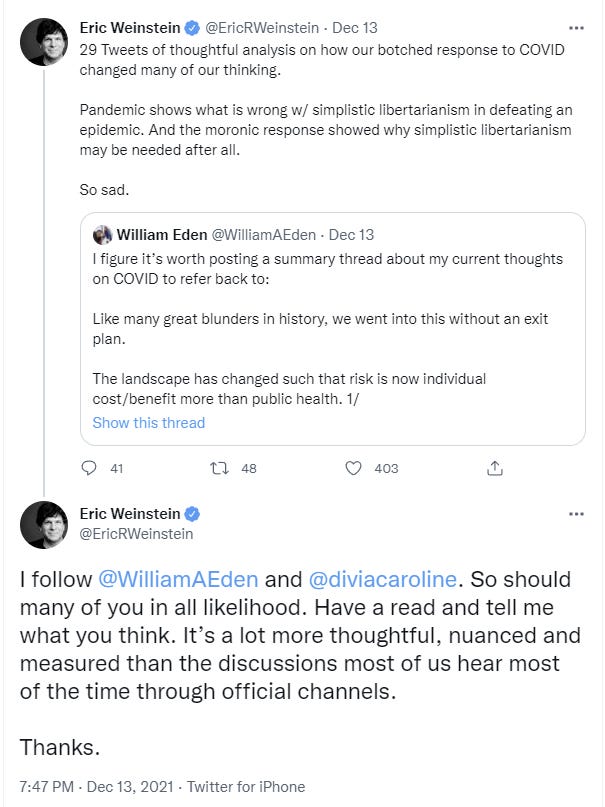
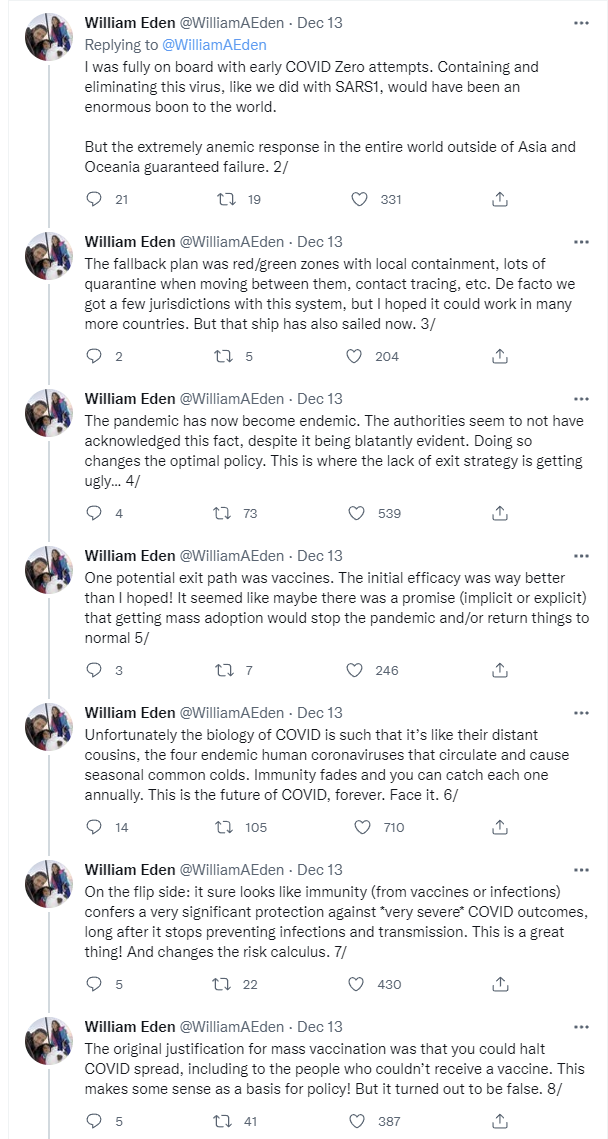
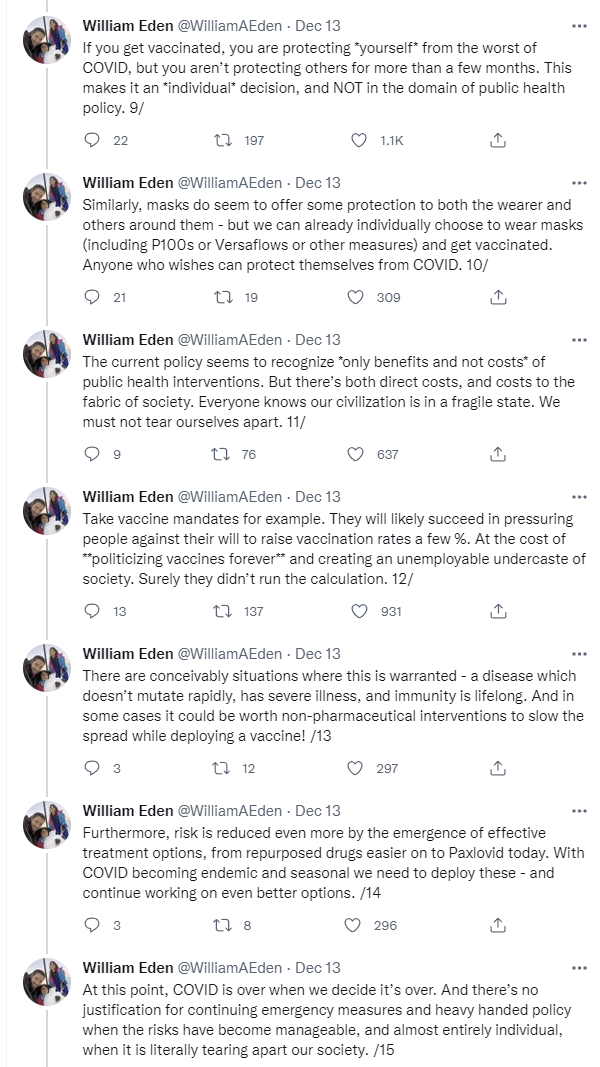
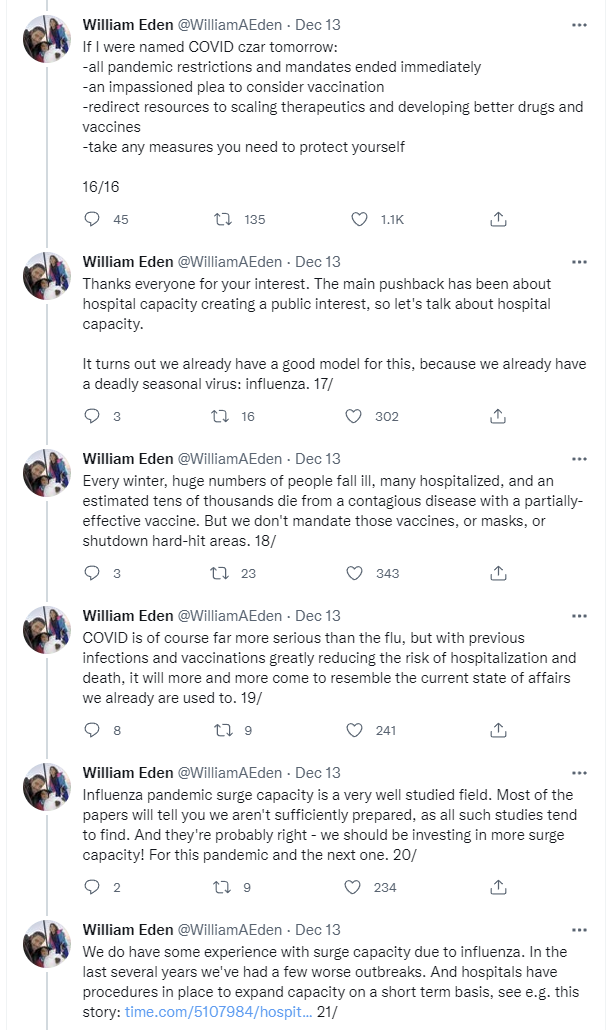
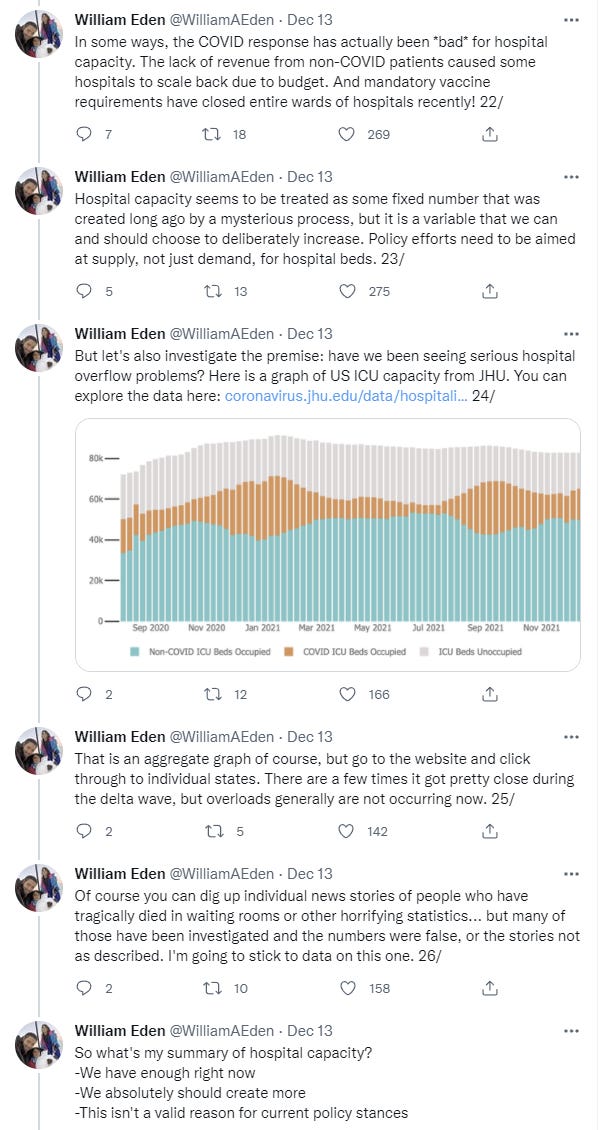
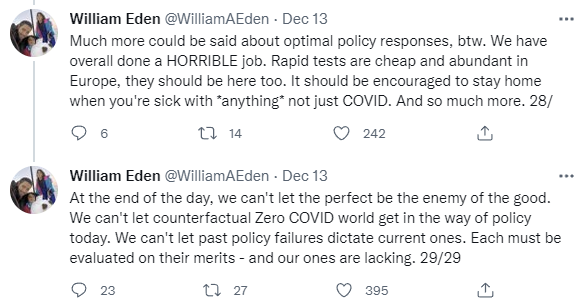
I could quibble but mostly I’m on the same page. The exception is that Omicron is about to come on stupidly fast, and that’s one curve that there could be a lot of value in flattening this (hopefully last) time, including to buy time for Paxlovid, but it doesn’t look like there’s that much capacity coming in time, the Omicron boosters are way too slow to make a difference, and generally the few ways to use the time we might buy have been ignored. It’s time to accept that it’s over.
Words of wisdom from Taleb on vaccine safety, for those who need them.
Hospitals in Minnesota already overwhelmed, and things are about to rapidly get much worse.
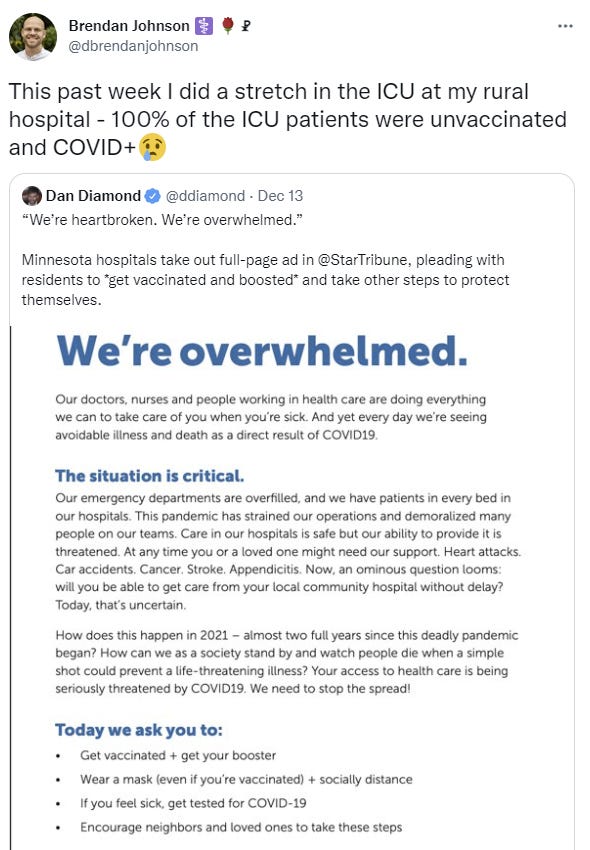
Thread discussing media coverage of the lab leak hypothesis, and in particular even now continued attempts to use frame manipulation on the social level to hammer people who don’t fall in line and agree to treat this highly plausible hypothesis as conspiracy theory, even as it was quietly removed entirely from the semi-official graphical conspiracy theory pyramid.

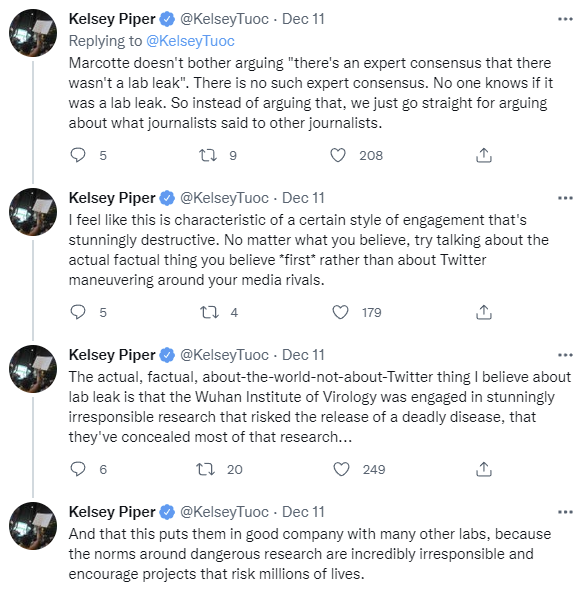
I strongly agree with Kelsey’s perspective here. Whether or not the virus came from a lab (and whether or not Omicron came from a lab), the gain of function research going on is stunningly irresponsible and we’re doing nothing to address this. Except it’s not merely a project that risks ‘millions of lives,’ it’s an existential risk that could potentially wipe out humanity or civilization. The next virus might not be this mild.
Meanwhile, this week there was a lab leak of Covid out of a BSL-3 lab in Taiwan.
That Atlantic article about how no one in someone’s town cares about Covid. It opens like this:
In November, my wife asked me whether I had seen an article with the remarkable headline “Is It Safe to Go to Thanksgiving Dinner?”
“Is that from last year?” I asked.
“No, it’s a few days old,” she said, her voice sinking to a growling murmur. “These people.”
These people, indeed.
Not Covid
Also Covid, but general and important:

FDA will make hearing aids less illegal, which is expected to increase availability while decreasing price, who knew? So in this case, the FDA has indeed stopped beating its wife. Which is good.
A bit on how they calculate hospital prices to put maximum pain on anyone foolish enough to show up without insurance but with money they can collect.

A couple weeks ago, I tried to find somewhere to get a booster before I went to see my grandma for Christmas. I didn’t see any open slots. I tried again last week; I saw a couple open slots the day before I left. I passed them up, because I really didn’t want to be going through side effects on the plane.
Plus, looking for open slots means looking at each pharmacy’s website individually, and clicking through their prescreening questionnaire each time.
If public health departments want people getting boosters, the first priority should be to make them available. The second priority should be to make them easy to schedule, with one place to query availability at multiple pharmacies.
Another datapoint: Reff of 3.5 estimated in Sydney/NSW currently, vast majority supposed to be Omicron. They’re at a 94% vaccination rate (in the eligible categories). https://www.reddit.com/r/CoronavirusDownunder/comments/ri1s0i/nsw_r_eff_as_of_december_17th_with_daily_cases/
I tried commenting on the last Omicron thread and it doesn’t show up. I hope you can re-add the Permanent Midnight section that’s about how the response metastasizes.
While making progresses in both of development and deployment of vaccinations is largely good, I think (from a right-wing view) the push for vaccine passports and mandates have been creating a mess. About boosters, while some passport regimes have already set an expiry date to mandate boosters, you should take a guess at the probability of variant-specific boosters being mandated for the vaccine passport, or else somewhere can’t be accessed. I think this will backfire horribly by creating a caste system based on a semi-random metric of what kinds of vaccines you have received, and ending ruining even more places than it is right now. It’s nightmarish to have such a situation if booster production fails to ramp up or they are deliberately denied to some group in order to foment divisiveness.
How does an universal vaccine mandate work in places where the vaccination rate tops out at a relatively low level, which means there are a large body of people who’ve decided never to vaccinate? Greece is fining the antivaxx seniors daily. There are right-wing fantasies of antivaxxers being sent to quarantine camps in train wagons and interned until they change their mind, Nazi-style. (I think this bit might be insensitive and potentially Anti-Semitic, but I’m just rephrasing what they’ve been expressing) What probability will you assign this? Hopefully low.
Update: My bad, I didn’t send the comment on the latest Omicron thread.
This is one of those something’s-gotta-give situations, if there’s a mandate with teeth and people do the most powerful thing available to most humans, to say the word ‘no’ and take the consequences, in sufficient numbers, they can either escalate again or give up. If you fight the law, usually the law wins, but not always.
The idea of quarantine camps for the unvaccinated seems like one of those really stupid policies in the sense that just physically force the jab on them already, it has less Unfortunate Implications. The mindset of ‘we can’t force you to X when we physically obviously could easily do that, but we will instead arrest you until you do X’ is nuts.
Also I think it’s important to notice that Nazis are right wing, and that which ‘wing’ is doing which half of this changes depending on details, and that anyone who actually cared about freedom at this point would be able to break free of the Hegelian dialectic.
Sorry if I sound too rightoid in the way I phrased the last comment, but there are way deeper right commenters than me here. Just thinking of the implications of the Permanent Midnight.
I don’t actually see such an internment as likely since the chain of lockdowns has shown that people can accept indefinite home confinement, and that would already be an acceptable punishment to the political establishment for disobeying vaccine mandates, since the value of “vaccination = resume normal lives” has been built up, and antivaxxers don’t expect things to return to the Old Normal anyway. In the US, even that will be flouted by Red Tribe members living away from centers of political authority, who are able to build alternative social structures which will also serve as a basis for their own economic and cultural practices. Federal mandates are already being invalidated on a county or even state (think DeSantis) level. Probably only the violent ones will be rounded up using antivaxx as a pretense, and some clampdown on them are long in the books. Not sure about Germany/Austria.
“if there’s a mandate with teeth and people do the most powerful thing available to most humans, to say the word ‘no’ and take the consequences, in sufficient numbers, they can either escalate again or give up. If you fight the law, usually the law wins, but not always.”
This is the antivaxx mindset as a political movement (instead of say, an epistemic framework or a set of beliefs to evaluate vaccine risk-benefit trade-off). This appears distinctly Randian and certainly framed in such terms especially by those who left work as a result of employee mandates. Going forward, political establishments across most countries are pursuing policies to maximize vaccine coverage even at the risk of escalating social disintegration, which I think are encouraged by the WHO. What this implies will be rightoid conspiracy theory territory.
“The mindset of ‘we can’t force you to X when we physically obviously could easily do that, but we will instead arrest you until you do X’ is nuts.”
COVID vaccination appeared voluntary at first, until the vaccine passports come, and then until mandates are imposed across the board, and punishments are being ratcheted up. It’s a tactic of creeping normality that aroused antivaxxers’ suspicion. I think internments can easily be the logical extreme of such a line of thought, but it is crossing the limit for many who has been toeing the provaxx line, since it damages the welfare of a significant group of people who nonetheless has been vilified by mainstream media. You can see that this will be an obvious target for opponents of various political orientations, even moderates who don’t want to see violation of some group’s security over such a public health policy.
It is a tragedy to see a somewhat safe and somewhat effective vaccine being the focus of culture wars and individualist (bio)politics, but then again it started with the lockdowns that has sensitized everyone’s fears. Tthe issues extend beyond lie in the vaccines themselves, to the passports and mandates that dictate more than your personal health choice.
[Since I’ve just started commenting here, I need to say what attitude I personally hold. I live somewhere where Zero COVID has been reality for several months, vaccine uptake is around 55-60%, the contract tracing app is often hated as a spying tool, and the vaccine passport is in its planning stages, to be rolled out only in next year. Easy enough to guess. It’s also a place where political thought has been parasitized by Trumpism and its antivaxx nastiness after serious pro-American civil unrest, which might or might not serve them well. I’m still planning to play by the rules and keep being vaccinated even if this sounds politically questionable, if only as a way not to end in deeper trouble.]
“Also I think it’s important to notice that Nazis are right wing, and that which ‘wing’ is doing which half of this changes depending on details, and that anyone who actually cared about freedom at this point would be able to break free of the Hegelian dialectic.”
If one cared about freedom winning in the short-term, adding one’s weight to an existing movement with ~half the population, major cultural momentum, and lots of existing state/local government power, that has some imperfections but no significant ones re restricting freedom, seems far more likely to work than starting a new movement from scratch.
Can’t let the wrong lizard win.
Jesus. As you’re well aware, the point is that instead of the 20th century “lizards fight each other and it doesn’t impact your life” paradigm, now one of the lizards attacks regular people to the point of forcing children to permanently mask and sit out on the cold concrete.
I might have a name that sounds like a troll (it’s actually about SSC commenter conventions/continuity, Emacs Lisp, and allowed character limitations) but a VERY high percentage of your responses to my comments read as low-effort trolling.
I appreciate that one could interpret that response as trolling rather than the shorthand I meant it as but… it’s not like anyone you’re making an argument I haven’t heard many, many times before in almost exactly those words? Presume I’ve already considered that argument, updated on it, and still disagree with you.
Also, I will simply note that when you say the other side is not a ‘threat to freedom’ that my response is something along the lines of ‘huh?’ and I’m intentionally NOT making an argument or providing here because I don’t want to have an argument about it. Simply providing the feedback that the sentence didn’t parse.
Other than not taking the bait and saying nothing I don’t know what I’m supposed to say, and I’m committing not to responding further here, and I will strive not to respond to similar provocations in the future.
This applies a little less to this particular case since Yellowface Anon started this topic, but for our similar past interactions:
If you want to avoid debating a topic so much that you won’t take the basic step of giving some kind of reason for your position to someone who asks, why not just avoid making the inflammatory claim in the first place?
Going back to Nate Silver’s breakdown of https://thezvi.wordpress.com/2021/08/12/covid-8-12-the-worst-is-over/, your “about half” is actually more like 25% plus some small percentage of Group Cs drifting to more indignant positions since then, Anonymous-backtick. Good if you can grab a few state like your type already do in FL/TX/SD, they can be counterpoints to the strictness in NY/CA and these states are already becoming home-moving magnets, but not game-changing. Unless there’s a big tipping point and either every other group converge onto your anti-mandate position for other ideological concerns, or GOP/Trumpists win big in 2022.
At this point, it is more like trading one bad option with another. Sure, you may offer economic and personal freedom at the 2019 level, but then some of your ideologues will restrict some freedoms which are still mutual exclusive to what the left-wing wants, because ideology.
“now one of the lizards attacks regular people to the point of forcing children to permanently mask and sit out on the cold concrete.”
Not permanent, maybe indefinite, for a few years at least. Pretty sure your type already have your children being homeschooled or sent to private schools without much of those rules. To each his own, and having more choices in education is actually a good thing. I stopped caring at this point and I’m already volcel.
What I said are just possible but unlikely (likely in the eyes of rightoids) scenarios where the power play is clearer than any justifiable public health benefit. (I’m pretty much going to be Gp. C after I take the vaccine right before the local vaccine passport comes)
It seems that you and William Eden agree that hospital capacity can be increased by throwing money at it, albeit at a longer timescale (or am I misreading?). I’ve seen many anecdotes of people leaving healthcare (or at least intensive care) due to perceived futility of their efforts and/or behaviour of patients. I haven’t seen any non-anecdotal evidence that this is happening with some reasonable frequency, but I did see evidence that people are leaving intensive care in general (e.g. the number of staffable ICU beds in Switzerland has decreased over the last 2 years). Do you think that this is a significant effect? Do you think it can be counterweighted by something else? Do you think it selects for some properties in future healthcare workers?
I mean hospital capacity can OBVIOUSLY be expanded with money. That’s the kind of thing money is very, very good at, at least on medium time scales. The question is, is it worth the cost?
We could also greatly expand medical capacity in general while reducing costs simply by reducing the regulatory burden. Expand residency slots, allow non-USA doctors to practice without a residency, expand what nurses and pharmacists can do for you without a doctor, expand what’s available over the counter, and you have a lot more flexibility with no downsides besides a pissed off union.
I strongly agree that given we have a limited supply already, that putting too much pressure on that supply is driving some of the supply out, making the problem worse, and it’s a big effect.
Quick question – Are comments on your coronavirus posts more heavily moderated? Or is there a blanket policy of not allowing posts with links? I’ve commented on some past posts and the comments did not show up.
WordPress automatically has filters, which I haven’t altered. If you include links, or otherwise raise flags, sometimes it flags your post for approval, and it’s possible it quietly black holes some of them. It’s not intentional, but I do get a lot of spam and it catches almost all of it, so I want to leave the filters working.
OK, that’s what I thought, just checking.
For predictions sake regarding Omicron people are obviously looking to see what has happened in South Africa as they are 3ish weeks ahead of the United States. I want to make a list of differences in order of importance between South Africa and the U.S. as these could potentially account for quite different outcomes.
1. Average age of South Africa is much lower-U.S. likely to do worse
2. It is summer in South Africa (higher Vitamin D levels could mean less severe outcomes, more outdoor activities and UV light could mean slower spread)
3. Immunity profile-South Africa has a lot of “natural infection” lower vaccination infection. South Africa had a different variant mix that contributed to that “natural immunity” than the U.S. I don’t know how this one plays out.
4. What am I missing? What country will come out worse in deaths+hospitalizations when this is over related to this omicron wave in per capita terms and what will the percentage difference be? I am predicting U.S. will have 35% more deaths+hospitalizations per capita on March 1st than South Africa had on Feb 7th. (The hospitalizations+deaths that I am referring to are those above the baseline per capita hospitalization+deaths each country had before Omicron wave began). Would anyone argue that displacement of Delta by Omicron in US will actually serve to lower the US baseline of hospitalizations+deaths?
South Africa is a very different society and not a great parallel for us. I think the thing to do right now is watch London and Denmark.
Agreed. I just want to look further into the future :).
Interesting and different take on South Africa peaking and modeling from an engineer type: https://www.youtube.com/watch?v=RWrjX1ty2EU
Letting the optimistic side of myself out of the cage for a moment, I’m going to point out that this way of thinking has never been applied to any other attempt forsee viral behavior based on their country of origin. Like, nobody said ‘bro India is such a different society, chill’ when Delta was manifesting.
Yes, everybody in the trial had COVID-19. So that leaves an ambiguity about side-effects in the control arm: were they were due to the placebo effect of being in the trial, or due to COVID-19? Either way, the treatment arm subjects were objectively better off (both in terms of strength of effect and statistical significance). In the end that’s what we care about most in a trial.
A minor qualification: that’s what I expect will happen first. Then, once we have real-world experience with paxlovid, it will probably be broadened. (RCT’s are great and all, but nothing beats actual combat experience in the field.)
(1) People will probably measure the rate of mutation in the 3CLpro protease of SARS-CoV2, to get some quantitative idea of whether we’re breeding resistant strains.
(2) Folklore will propagate among clinicians about drug interactions (mostly with ritonavir, which is in some ways designed to mess with drug metabolism to make drugs stay in your body longer).
Once there’s pretty good reassurance on those 2 issues, I predict there will be a great hammering at the gates of the FDA demanding wider authorization. Or, for that matter, just plain old full-up approval, at which point prescribing physicians can do more or less what they want.
On that note, I just saw (2 days late, sorry) that the Europeans have (sort of) granted their version of Emergency Use Authorization for paxlovid! I say “sort of”, because it’s under the somewhat convoluted EU regulations: the EMA advised the national medical authorities of the member states that it’s ok to grant emergency use of paxlovid in their countries, if they feel like it. It’s not so much the final action, as the removal of a road-block so that the member states can take action if they want, which they probably will.
(It’s almost like if the FDA could only block things, and state governments had to do the authorization. Then this is like the FDA saying to the 50 states that they could go ahead if they wanted. Imagine the chaos, and how different it would be from the chaos which we now enjoy.)
Another prediction: once paxlovid (or for that matter, molnupiravir) is available, there will be a choke point on testing, both in availability and cost. Easily available and free or nearly so tests will be essential to get to people within that crucial 3-5 days after symptoms. I kind of doubt we’ll get it right, but would love to be surprised in that regard.
No you are obviously right about testing because we are already out of tests now.
My presumption is the true reason for narrow approval is to ration supply. When supply is ample, they will find a way to full approval unless something bad happens first.
Reuters reported this morning that anonymous sources “familiar with the matter” predict approval of molnupiravir and paxlovid this week, possibly tomorrow.
Yeah, I know. Basically a rumor that we can’t check. Still, it would be really good news.
And this morning, they did it: the FDA granted Emergency Use Authorization for paxlovid.
More later as I plow through the docs.
No movement on molnupiravir, which I suspect is now dead in the water.
Yep, on it, curious to hear your take.
If I was FDA I wouldn’t have authorized it for prevention either, because of limited supply, so doctors are less tempted to use it inefficiently. Can go back and fix later.
Dear Zvi, can I kindly ask you for some help with the calculations?
I worry that the omicron infection might be inevitable in the case of my family, or at least very likely (40-80%) given the common ventilation ducts in my building. All my family members [M30, M55, F65, F88] got double-vaccinated with Pfizer in June. I [M30] felt really bad after each shot, plus I’m concerned (maybe too much) about the “possibly downplayed cardiovascular risks concerning young males”. My family is also reluctant to get a booster shot, but I feel it would be even more justified in their case if they could get it in the next ~7 days.
Assuming the omicron infection, can I kindly ask you to provide the probability estimates for a “moderate or severe” course, death, and long Covid in case of my four family members, with our current vaccination status vs. with a booster?
On top of that, Paxlovid is inaccessible in my country, and I don’t know how to get it. I also worry that the healthcare system will collapse, resulting in the inaccessibility of ventilators/ICUs and numerous non-Covid-19 deaths, just as it happened last year in my country. :(
Paxlovid inaccessible everywhere for now. Don’t know where you are, but health care everywhere will at least be under strain.
I agree that exposure is going to be very difficult to avoid. I would *strongly* urge anyone older to get their boosters as soon as possible. My guess is conditional on infection, for severe disease, start with the standard age/risk chart, reduce maybe 20% in expectation for Omicron (might be 0%, might be more, we don’t know), and then reduce 80% for two shots, which a booster moves to 95% (so a further 75% or so). For death, maybe 85% and 97%, or something. But it’s too early to know how this works and we weren’t even all that confident with regard to Delta. I wish I could be more definite, and if I figure out good answers I’ll frontline them.
If the medical system is overworked and you can’t get proper treatment, multiply all risk by a factor of 5-10.
For long covid, no one knows how much boosting helps beyond avoiding infection. My guess is somewhat. I’m guessing a few percent to get something meaningful as a baseline, but this gets into model uncertainty and all that.
Thank you. I have data on hospitalizations and death by age and sex, plus long Covid guesstimates. Could you share estimates of the “moderate-to-severe” course, covering cases as bad as the top 50% worse cases of the regular flu, and worse ones?
Also, if I calculate properly (and I might not under the stress…), the cumulative death risk for double-vaccinated 30/55/65 yo family members is relatively low (together: 0.2% if healthcare available, 1-2% if unavailable), but high for the 88yo (2% if healthcare available, 10-20% if unavailable).
Zvi – I have some a bit of confusion about how variants spread, and specifically how new variants so quicky totally outcompete previous, less transmissible variants. Thinking back to when alpha was completely dominant in the US — I’m thinking like 75+%. Then comes delta and in a few months it’s 99+% delta. So delta totally outcompeted alpha.
How does that work, and particularly, how does it work so quickly? Especially during the alpha->delta transition, there were so many uninflected people it seems like both should be able to exist, with delta having the lion’s share of cases (perhaps vast majority), but with alpha still at a nontrivial percentage (think homo sapiens and Neanderthals co-existing for a long time). But actually, alpha essentially totally vanished. The sort of “almost all alpha” -> “almost all delta” transition we’re saw feels like it should take orders of magnitudes longer (years or decades). Someone infected with alpha, in a low immunity community, should still be able to pass on alpha to someone, even if it’s with lower efficiency than someone with delta transmits and so pockets.
The sort of transition we saw could make sense with much lower case counts potentially (i.e., 100 alpha cases growing with a doubling rate of 10 days vs. 100 delta cases with a doubling rate of 5 days would very rapidly turn into ~99%+ delta), but at the point at which we saw the alpha->delta transition, there were almost certainly *millions* of active alpha cases in the US so that can’t be it. These millions of cases should presumably still be able to continue infecting new people, even with a fitter variant out there in delta.
In other words, at the time of the alpha->delta transition, we didn’t just see the *share* of alpha cases decline, but we almost certainly saw the raw number of alpha cases decline rather dramatically (testing issues make it hard to be sure how dramatically).
I’m wondering if the speed of this transition, and the seemingly inevitable delta->omicron transition point to a heterogeneous susceptibility variable between variants. IOW, perhaps at the time of the alpha->delta transition, alpha had already come close to totally running through it’s pool of easily susceptible people, which would explain why we saw such a rapid decline in the raw number of alpha cases. And then delta comes along, and isn’t just fitter because it lives longer in the air or something, but because it has some mutation that gives it ‘access to’ a previously unavailable population. This doesn’t really explain the issue of how delta’s emergence would *cause* alpha cases to so precipitously decline however.
(I apologize for the wall of text, but googling these issues results in predictably illegible results, so you’re the best resource I can think of).
Short answer is that exponential growth is a hell of a drug. If Delta>Alpha by 40%/cycle with a 5-day cycle, then it in relative terms doubles every two cycles, so you go from 10% of Alpha to 20% to 40% in one month, then 320% (so 76% of cases), and so on. There’s nothing mysterious here. The raw numbers decline because people take measures in response to Delta to reduce spread, which also hammers Alpha’s raw numbers, and also that Alpha was going to get suppressed anyway when vaccinations kicked in.
The other thing that might be happening is that Omicron could have a faster cycle than Delta, either instead of or in addition to a transmission advantage. (Probably couldn’t explain what we’ve seen so far with *just* a faster serial interval, but that could be a part of it.)
This somewhat makes sense, although the extremeness of the effect, especially on the raw numbers front is surprising.
Delta was at ~1% prevalence on May 3, 2021, meaning Alpha and the various older strains were at 99%. At that point we were seeing about ~50K reported cases/day (true number unknown), which I’ll group as the legacy strains. Delta reached 99% prevalence by August 23, at which point we were seeing ~140K reported cases/day. At a 99/1 ratio, that’s roughly 138.6K delta confirmed cases, and 1.4k legacy confirmed cases.
The implication is that the mitigation measures people took in response to Delta + vaccines would have have reduced that ~50K/day figure from early May to *1.4*K/day by early August? That seems fairly extreme, even with the control mechanism and vaccines.
It seems like we’re seeing something similar and confusing happen with Delta vanishing “too fast” now. A week ago, we were at 99% Delta and ~130K cases/day (so essentially 130K Delta cases). Today we’re at ~73% Omicron and 150K cases/day (reported), meaning we’re down to ~40K delta cases/day, at a time when case counts were increasing anyway for seasonal reasons.
Now, there’s reporting lag issues, and variable testing capacity issues, but back of the envelope, we’ve “lost” 90K delta cases in a week, at a time when we’d otherwise expect cases to keep rising. Is this really just the Omicron control mechanism? That seems a bit much, no?